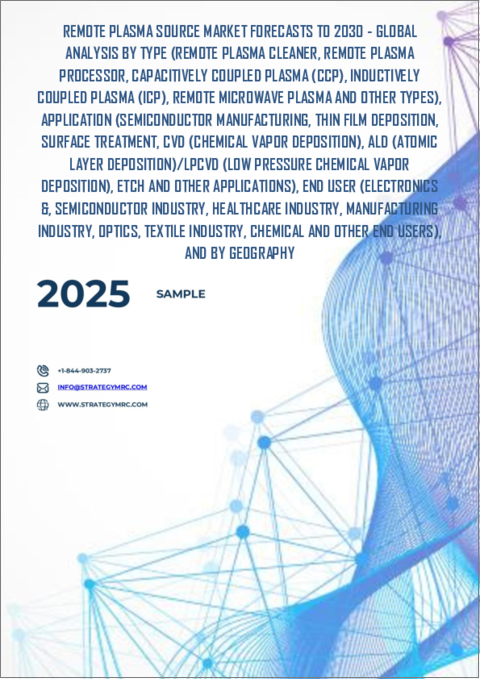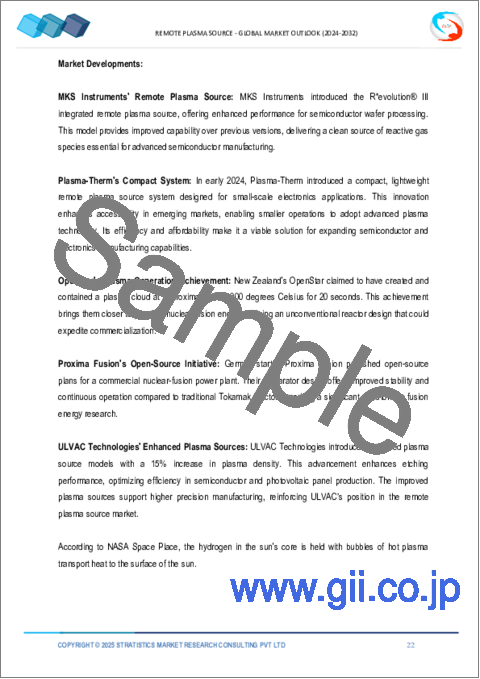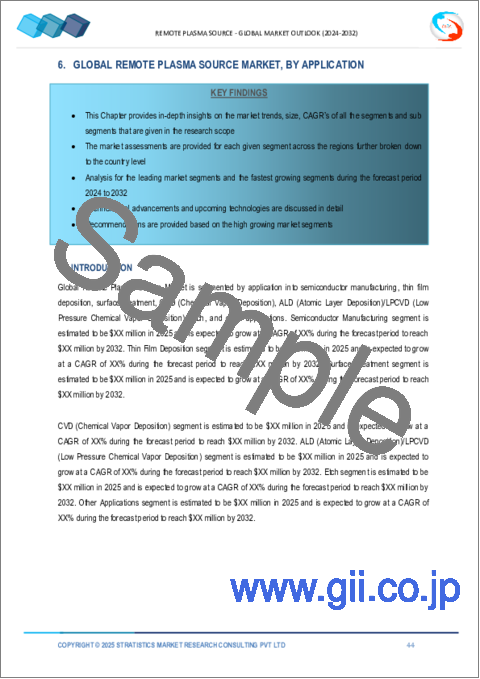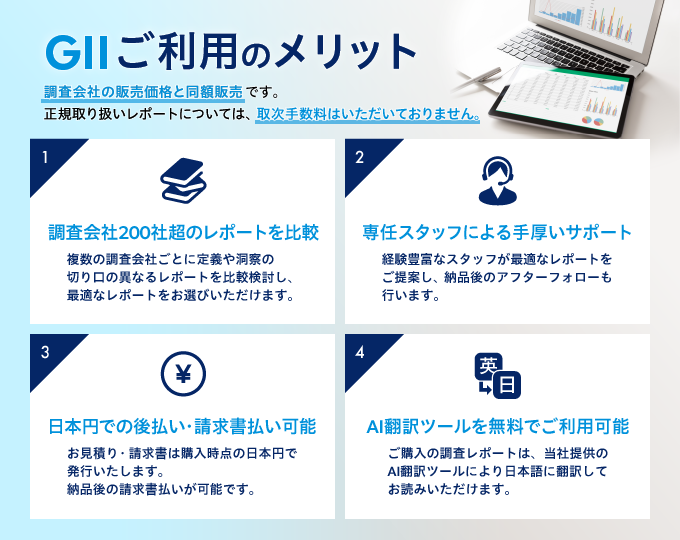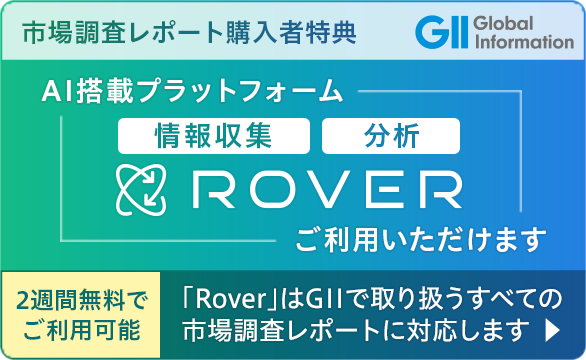|
|
市場調査レポート
商品コード
1351106
リモートプラズマソース市場の2030年までの予測- タイプ別、用途別、エンドユーザー別、地域別の世界分析Remote Plasma Source Market Forecasts to 2030 - Global Analysis By Type, Application, End User, and By Geography |
||||||
カスタマイズ可能
|
|||||||
| リモートプラズマソース市場の2030年までの予測- タイプ別、用途別、エンドユーザー別、地域別の世界分析 |
|
出版日: 2023年09月01日
発行: Stratistics Market Research Consulting
ページ情報: 英文 175+ Pages
納期: 2~3営業日
|
- 全表示
- 概要
- 図表
- 目次
Stratistics MRCによると、リモートプラズマソースの世界市場は、2023年に3億6,195万米ドルを占め、予測期間中にCAGR 22.2%で成長し、2030年には14億7,283万米ドルに達する見込みです。
炭化水素系汚染物質の除去は、従来のガスパージ技術では極めて困難であるため、真空チャンバ内にリモートプラズマソースを設置します。半導体プロセスにおけるフォトレジストのドライ除去を含むアプリケーションでは、リモートプラズマソースが一般的に使用されます。さらに、表面を分子レベルでクリーンにするために、不純物の最終層を除去するためにも使用できます。
NASAスペースプレイスによると、太陽のコアの水素は、高温プラズマの泡で保持され、太陽表面に熱を輸送します。
半導体製造の採用増加
半導体産業は、家電製品、自動車技術、モノのインターネット(IoT)の進歩に後押しされたエレクトロニクス需要の高まりに支えられています。さらに、チップ設計がより複雑になり、より微細なエッチングや成膜プロセスが求められるようになるにつれて、RPS技術の需要が高まっています。また、半導体製造の先端ノードへの移行は、精密なプラズマ処理に大きく依存するため、RPSシステムの普及が進んでいます。
高い初期費用
リモートプラズマソース(RPS)システムを導入するための高額な初期費用には、資本設備、設置費用、トレーニングとスキル開発、継続的なメンテナンスとサポート契約、安全対策とコンプライアンス対策、運用規模、ROIの考慮、資金調達の難しさ、予算の制約、資産管理の問題などが含まれます。その他の特典として、RPS技術の導入が長期的な事業目標に沿ったものであり、前向きな投資対効果をもたらすことを保証するために、資金調達の選択肢を検討し、政府のインセンティブを探し、広範な費用便益分析を行うなど、慎重な計画が要求されます。
新市場での販売拡大
RPS技術は、5G通信、電気自動車(EV)の製造、再生可能エネルギーなどの発展産業において、大きな可能性を秘めています。これらの産業は、コンポーネントの製造と改良のために精密なプラズマプロセスを必要とし、RPSメーカーにエキサイティングな新市場機会を提供します。さらに、RPS技術の精度と適応性は、これらの産業が拡大し続ける中で、その発展を可能にする重要な要素となっています。
技術の陳腐化
プラズマ技術の急速な進歩により、既存のシステムがすぐに陳腐化するRPS市場では、技術の陳腐化は深刻な脅威です。企業が生き残るためには、RPSソリューションを市場の最先端で競争力を維持するための研究開発に継続的に投資する必要があります。さらに、技術的陳腐化への対処を怠ると、競争優位性の喪失、市場関連性の低下、潜在的な収益の減少につながる可能性があります。
COVID-19の影響:
COVID-19の流行はRPS市場に大きな影響を与え、サプライチェーンを混乱させ、設置を遅らせ、影響を受けた業界に設備投資を削減させ、市場の成長を一時的に鈍化させました。さらに、企業は遠隔保守を実施し、医療機器の製造のようなパンデミックに関連する分野のアプリケーションを調査することで適応しました。遠隔操作で業務を管理するため、企業はデジタル化への取り組みを強化し、パンデミックは俊敏なサプライチェーン戦略の価値を浮き彫りにしました。
予測期間中、誘導結合プラズマセグメントが最大になる見込み
予測期間中、誘導結合プラズマ(ICP)が最大の市場シェアを占めると予測されています。ICPシステムは、精密で制御されたプロセス用の高密度で安定したプラズマを生成できるため、半導体製造、環境分析、元素分析などさまざまな産業で広く使用されています。さらに、ICP技術の適応性の高さから、材料の表面処理から分析分光学に至るまで幅広い用途で最有力な選択肢となっており、市場での優位性を大いに高めています。
ヘルスケア産業セグメントは予測期間中最も高いCAGRが見込まれる
市場のCAGRが最も高いと予想されるのはヘルスケア産業です。最先端の医薬品、診断薬、医療機器の需要は、すべて精密で制御されたプラズマプロセスに依存しており、これがこの成長の原動力となっています。滅菌、医療機器の表面改質、ドラッグデリバリーシステム、新規治療法の開発はすべてRPS技術に大きく依存しています。さらに、RPS市場におけるこの産業セグメントの継続的な拡大と隆盛は、医療進歩の継続的な追求とヘルスケア分野におけるよりクリーンで効果的な製造プロセスへの要求にも起因しています。
最大シェアの地域
RPS(リモートプラズマソース)の最大市場シェアはアジア太平洋地域です。中国、韓国、台湾、日本などの国々では、エレクトロニクスや半導体の生産が盛んです。これらの国々は世界的に半導体の主要生産国であり、最先端の生産方法としてRPS技術に大きく依存しています。さらに、この地域の市場シェアは、ヘルスケアや再生可能エネルギーを含む様々なアプリケーションのために新興経済国でのRPSシステムの使用が増加していることによって強化されています。アジア太平洋地域は、これらの重要な分野への実質的な関与と技術投資の拡大により、現在、世界のRPS市場に最も貢献しています。
CAGRが最も高い地域:
RPS(リモートプラズマソース)市場はまた、北米で最も速い速度で成長しています。同地域の成長には、米国とカナダを中心とする半導体産業の存在感が大きく寄与しています。これらの国々は世界の半導体製造産業に大きく貢献しており、最先端のチップ製造技術をサポートするRPS技術へのニーズが高まっています。さらに、RPSシステムの採用は、北米の研究開発、および5G技術や電気自動車製造のような最先端産業における技術革新に重点を置くことによってさらに促進されます。
無料のカスタマイズ提供
本レポートをご購読のお客様には、以下の無料カスタマイズオプションのいずれかをご利用いただけます:
- 企業プロファイル
- 追加市場プレイヤーの包括的プロファイリング(3社まで)
- 主要企業のSWOT分析(3社まで)
- 地域セグメンテーション
- 顧客の関心に応じた主要国の市場推計・予測・CAGR(注:フィージビリティチェックによる)
- 競合ベンチマーキング
- 製品ポートフォリオ、地理的プレゼンス、戦略的提携に基づく主要企業のベンチマーキング
目次
第1章 エグゼクティブサマリー
第2章 序文
- 概要
- ステークホルダー
- 調査範囲
- 調査手法
- データマイニング
- データ分析
- データ検証
- 調査アプローチ
- 調査ソース
- 1次調査ソース
- 2次調査ソース
- 前提条件
第3章 市場動向分析
- 促進要因
- 抑制要因
- 機会
- 脅威
- アプリケーション分析
- エンドユーザー分析
- 新興市場
- 新型コロナウイルス感染症(COVID-19)の影響
第4章 ポーターのファイブフォース分析
- 供給企業の交渉力
- 買い手の交渉力
- 代替品の脅威
- 新規参入業者の脅威
- 競争企業間の敵対関係
第5章 世界のリモートプラズマソース市場:タイプ別
- リモートプラズマクリーナー
- リモートプラズマプロセッサ
- 容量結合プラズマ(CCP)
- 誘導結合プラズマ(ICP)
- リモートマイクロ波プラズマ
- その他のタイプ
第6章 世界のリモートプラズマソース市場:用途別
- 半導体製造
- 薄膜堆積
- 表面処理
- CVD(化学蒸着)
- ALD(原子層堆積)/LPCVD(減圧化学気相成長)
- エッチ
- その他の用途
第7章 世界のリモートプラズマソース市場:エンドユーザー別
- 電子・半導体産業
- ヘルスケア産業
- 製造業
- 光学
- 織物産業
- 化学薬品
- その他のエンドユーザー
第8章 世界のリモートプラズマソース市場:地域別
- 北米
- 米国
- カナダ
- メキシコ
- 欧州
- ドイツ
- 英国
- イタリア
- フランス
- スペイン
- その他欧州
- アジア太平洋地域
- 日本
- 中国
- インド
- オーストラリア
- ニュージーランド
- 韓国
- その他アジア太平洋地域
- 南米
- アルゼンチン
- ブラジル
- チリ
- その他南米
- 中東とアフリカ
- サウジアラビア
- アラブ首長国連邦
- カタール
- 南アフリカ
- その他中東とアフリカ
第9章 主な発展
- 契約、パートナーシップ、コラボレーション、合弁事業
- 買収と合併
- 新製品の発売
- 事業拡大
- その他の主要戦略
第10章 企業プロファイル
- T-M Vacuum Products, Inc.
- Lam Research Corporation
- Sentech Instruments GmbH
- Advanced Energy Industries, Inc.
- Plasma Etch, Inc.
- Muegge GmbH
- PIE Scientific LLC.
- ADTEC Plasma Technology Co., Ltd.
- Rave Scientific
- PVA TePla AG
- MKS Instruments.
- Samco Inc.
- Oxford Instruments plc
- XEI Scientific, Inc.
List of Tables
- Table 1 Global Remote Plasma Source Market Outlook, By Region (2021-2030) ($MN)
- Table 2 Global Remote Plasma Source Market Outlook, By Type (2021-2030) ($MN)
- Table 3 Global Remote Plasma Source Market Outlook, By Remote Plasma Cleaner (2021-2030) ($MN)
- Table 4 Global Remote Plasma Source Market Outlook, By Remote Plasma Processor (2021-2030) ($MN)
- Table 5 Global Remote Plasma Source Market Outlook, By Capacitively Coupled Plasma (CCP) (2021-2030) ($MN)
- Table 6 Global Remote Plasma Source Market Outlook, By Inductively Coupled Plasma (ICP) (2021-2030) ($MN)
- Table 7 Global Remote Plasma Source Market Outlook, By Remote Microwave Plasma (2021-2030) ($MN)
- Table 8 Global Remote Plasma Source Market Outlook, By Other Types (2021-2030) ($MN)
- Table 9 Global Remote Plasma Source Market Outlook, By Application (2021-2030) ($MN)
- Table 10 Global Remote Plasma Source Market Outlook, By Semiconductor Manufacturing (2021-2030) ($MN)
- Table 11 Global Remote Plasma Source Market Outlook, By Thin Film Deposition (2021-2030) ($MN)
- Table 12 Global Remote Plasma Source Market Outlook, By Surface Treatment (2021-2030) ($MN)
- Table 13 Global Remote Plasma Source Market Outlook, By CVD (Chemical Vapor Deposition) (2021-2030) ($MN)
- Table 14 Global Remote Plasma Source Market Outlook, By ALD (Atomic Layer Deposition)/LPCVD (Low Pressure Chemical Vapor Deposition) (2021-2030) ($MN)
- Table 15 Global Remote Plasma Source Market Outlook, By Etch (2021-2030) ($MN)
- Table 16 Global Remote Plasma Source Market Outlook, By Other Applications (2021-2030) ($MN)
- Table 17 Global Remote Plasma Source Market Outlook, By End User (2021-2030) ($MN)
- Table 18 Global Remote Plasma Source Market Outlook, By Electronics & Semiconductor industry (2021-2030) ($MN)
- Table 19 Global Remote Plasma Source Market Outlook, By Healthcare Industry (2021-2030) ($MN)
- Table 20 Global Remote Plasma Source Market Outlook, By Manufacturing Industry (2021-2030) ($MN)
- Table 21 Global Remote Plasma Source Market Outlook, By Optics (2021-2030) ($MN)
- Table 22 Global Remote Plasma Source Market Outlook, By Textile Industry (2021-2030) ($MN)
- Table 23 Global Remote Plasma Source Market Outlook, By Chemical (2021-2030) ($MN)
- Table 24 Global Remote Plasma Source Market Outlook, By Other End Users (2021-2030) ($MN)
- Table 25 North America Remote Plasma Source Market Outlook, By Country (2021-2030) ($MN)
- Table 26 North America Remote Plasma Source Market Outlook, By Type (2021-2030) ($MN)
- Table 27 North America Remote Plasma Source Market Outlook, By Remote Plasma Cleaner (2021-2030) ($MN)
- Table 28 North America Remote Plasma Source Market Outlook, By Remote Plasma Processor (2021-2030) ($MN)
- Table 29 North America Remote Plasma Source Market Outlook, By Capacitively Coupled Plasma (CCP) (2021-2030) ($MN)
- Table 30 North America Remote Plasma Source Market Outlook, By Inductively Coupled Plasma (ICP) (2021-2030) ($MN)
- Table 31 North America Remote Plasma Source Market Outlook, By Remote Microwave Plasma (2021-2030) ($MN)
- Table 32 North America Remote Plasma Source Market Outlook, By Other Types (2021-2030) ($MN)
- Table 33 North America Remote Plasma Source Market Outlook, By Application (2021-2030) ($MN)
- Table 34 North America Remote Plasma Source Market Outlook, By Semiconductor Manufacturing (2021-2030) ($MN)
- Table 35 North America Remote Plasma Source Market Outlook, By Thin Film Deposition (2021-2030) ($MN)
- Table 36 North America Remote Plasma Source Market Outlook, By Surface Treatment (2021-2030) ($MN)
- Table 37 North America Remote Plasma Source Market Outlook, By CVD (Chemical Vapor Deposition) (2021-2030) ($MN)
- Table 38 North America Remote Plasma Source Market Outlook, By ALD (Atomic Layer Deposition)/LPCVD (Low Pressure Chemical Vapor Deposition) (2021-2030) ($MN)
- Table 39 North America Remote Plasma Source Market Outlook, By Etch (2021-2030) ($MN)
- Table 40 North America Remote Plasma Source Market Outlook, By Other Applications (2021-2030) ($MN)
- Table 41 North America Remote Plasma Source Market Outlook, By End User (2021-2030) ($MN)
- Table 42 North America Remote Plasma Source Market Outlook, By Electronics & Semiconductor industry (2021-2030) ($MN)
- Table 43 North America Remote Plasma Source Market Outlook, By Healthcare Industry (2021-2030) ($MN)
- Table 44 North America Remote Plasma Source Market Outlook, By Manufacturing Industry (2021-2030) ($MN)
- Table 45 North America Remote Plasma Source Market Outlook, By Optics (2021-2030) ($MN)
- Table 46 North America Remote Plasma Source Market Outlook, By Textile Industry (2021-2030) ($MN)
- Table 47 North America Remote Plasma Source Market Outlook, By Chemical (2021-2030) ($MN)
- Table 48 North America Remote Plasma Source Market Outlook, By Other End Users (2021-2030) ($MN)
- Table 49 Europe Remote Plasma Source Market Outlook, By Country (2021-2030) ($MN)
- Table 50 Europe Remote Plasma Source Market Outlook, By Type (2021-2030) ($MN)
- Table 51 Europe Remote Plasma Source Market Outlook, By Remote Plasma Cleaner (2021-2030) ($MN)
- Table 52 Europe Remote Plasma Source Market Outlook, By Remote Plasma Processor (2021-2030) ($MN)
- Table 53 Europe Remote Plasma Source Market Outlook, By Capacitively Coupled Plasma (CCP) (2021-2030) ($MN)
- Table 54 Europe Remote Plasma Source Market Outlook, By Inductively Coupled Plasma (ICP) (2021-2030) ($MN)
- Table 55 Europe Remote Plasma Source Market Outlook, By Remote Microwave Plasma (2021-2030) ($MN)
- Table 56 Europe Remote Plasma Source Market Outlook, By Other Types (2021-2030) ($MN)
- Table 57 Europe Remote Plasma Source Market Outlook, By Application (2021-2030) ($MN)
- Table 58 Europe Remote Plasma Source Market Outlook, By Semiconductor Manufacturing (2021-2030) ($MN)
- Table 59 Europe Remote Plasma Source Market Outlook, By Thin Film Deposition (2021-2030) ($MN)
- Table 60 Europe Remote Plasma Source Market Outlook, By Surface Treatment (2021-2030) ($MN)
- Table 61 Europe Remote Plasma Source Market Outlook, By CVD (Chemical Vapor Deposition) (2021-2030) ($MN)
- Table 62 Europe Remote Plasma Source Market Outlook, By ALD (Atomic Layer Deposition)/LPCVD (Low Pressure Chemical Vapor Deposition) (2021-2030) ($MN)
- Table 63 Europe Remote Plasma Source Market Outlook, By Etch (2021-2030) ($MN)
- Table 64 Europe Remote Plasma Source Market Outlook, By Other Applications (2021-2030) ($MN)
- Table 65 Europe Remote Plasma Source Market Outlook, By End User (2021-2030) ($MN)
- Table 66 Europe Remote Plasma Source Market Outlook, By Electronics & Semiconductor industry (2021-2030) ($MN)
- Table 67 Europe Remote Plasma Source Market Outlook, By Healthcare Industry (2021-2030) ($MN)
- Table 68 Europe Remote Plasma Source Market Outlook, By Manufacturing Industry (2021-2030) ($MN)
- Table 69 Europe Remote Plasma Source Market Outlook, By Optics (2021-2030) ($MN)
- Table 70 Europe Remote Plasma Source Market Outlook, By Textile Industry (2021-2030) ($MN)
- Table 71 Europe Remote Plasma Source Market Outlook, By Chemical (2021-2030) ($MN)
- Table 72 Europe Remote Plasma Source Market Outlook, By Other End Users (2021-2030) ($MN)
- Table 73 Asia Pacific Remote Plasma Source Market Outlook, By Country (2021-2030) ($MN)
- Table 74 Asia Pacific Remote Plasma Source Market Outlook, By Type (2021-2030) ($MN)
- Table 75 Asia Pacific Remote Plasma Source Market Outlook, By Remote Plasma Cleaner (2021-2030) ($MN)
- Table 76 Asia Pacific Remote Plasma Source Market Outlook, By Remote Plasma Processor (2021-2030) ($MN)
- Table 77 Asia Pacific Remote Plasma Source Market Outlook, By Capacitively Coupled Plasma (CCP) (2021-2030) ($MN)
- Table 78 Asia Pacific Remote Plasma Source Market Outlook, By Inductively Coupled Plasma (ICP) (2021-2030) ($MN)
- Table 79 Asia Pacific Remote Plasma Source Market Outlook, By Remote Microwave Plasma (2021-2030) ($MN)
- Table 80 Asia Pacific Remote Plasma Source Market Outlook, By Other Types (2021-2030) ($MN)
- Table 81 Asia Pacific Remote Plasma Source Market Outlook, By Application (2021-2030) ($MN)
- Table 82 Asia Pacific Remote Plasma Source Market Outlook, By Semiconductor Manufacturing (2021-2030) ($MN)
- Table 83 Asia Pacific Remote Plasma Source Market Outlook, By Thin Film Deposition (2021-2030) ($MN)
- Table 84 Asia Pacific Remote Plasma Source Market Outlook, By Surface Treatment (2021-2030) ($MN)
- Table 85 Asia Pacific Remote Plasma Source Market Outlook, By CVD (Chemical Vapor Deposition) (2021-2030) ($MN)
- Table 86 Asia Pacific Remote Plasma Source Market Outlook, By ALD (Atomic Layer Deposition)/LPCVD (Low Pressure Chemical Vapor Deposition) (2021-2030) ($MN)
- Table 87 Asia Pacific Remote Plasma Source Market Outlook, By Etch (2021-2030) ($MN)
- Table 88 Asia Pacific Remote Plasma Source Market Outlook, By Other Applications (2021-2030) ($MN)
- Table 89 Asia Pacific Remote Plasma Source Market Outlook, By End User (2021-2030) ($MN)
- Table 90 Asia Pacific Remote Plasma Source Market Outlook, By Electronics & Semiconductor industry (2021-2030) ($MN)
- Table 91 Asia Pacific Remote Plasma Source Market Outlook, By Healthcare Industry (2021-2030) ($MN)
- Table 92 Asia Pacific Remote Plasma Source Market Outlook, By Manufacturing Industry (2021-2030) ($MN)
- Table 93 Asia Pacific Remote Plasma Source Market Outlook, By Optics (2021-2030) ($MN)
- Table 94 Asia Pacific Remote Plasma Source Market Outlook, By Textile Industry (2021-2030) ($MN)
- Table 95 Asia Pacific Remote Plasma Source Market Outlook, By Chemical (2021-2030) ($MN)
- Table 96 Asia Pacific Remote Plasma Source Market Outlook, By Other End Users (2021-2030) ($MN)
- Table 97 South America Remote Plasma Source Market Outlook, By Country (2021-2030) ($MN)
- Table 98 South America Remote Plasma Source Market Outlook, By Type (2021-2030) ($MN)
- Table 99 South America Remote Plasma Source Market Outlook, By Remote Plasma Cleaner (2021-2030) ($MN)
- Table 100 South America Remote Plasma Source Market Outlook, By Remote Plasma Processor (2021-2030) ($MN)
- Table 101 South America Remote Plasma Source Market Outlook, By Capacitively Coupled Plasma (CCP) (2021-2030) ($MN)
- Table 102 South America Remote Plasma Source Market Outlook, By Inductively Coupled Plasma (ICP) (2021-2030) ($MN)
- Table 103 South America Remote Plasma Source Market Outlook, By Remote Microwave Plasma (2021-2030) ($MN)
- Table 104 South America Remote Plasma Source Market Outlook, By Other Types (2021-2030) ($MN)
- Table 105 South America Remote Plasma Source Market Outlook, By Application (2021-2030) ($MN)
- Table 106 South America Remote Plasma Source Market Outlook, By Semiconductor Manufacturing (2021-2030) ($MN)
- Table 107 South America Remote Plasma Source Market Outlook, By Thin Film Deposition (2021-2030) ($MN)
- Table 108 South America Remote Plasma Source Market Outlook, By Surface Treatment (2021-2030) ($MN)
- Table 109 South America Remote Plasma Source Market Outlook, By CVD (Chemical Vapor Deposition) (2021-2030) ($MN)
- Table 110 South America Remote Plasma Source Market Outlook, By ALD (Atomic Layer Deposition)/LPCVD (Low Pressure Chemical Vapor Deposition) (2021-2030) ($MN)
- Table 111 South America Remote Plasma Source Market Outlook, By Etch (2021-2030) ($MN)
- Table 112 South America Remote Plasma Source Market Outlook, By Other Applications (2021-2030) ($MN)
- Table 113 South America Remote Plasma Source Market Outlook, By End User (2021-2030) ($MN)
- Table 114 South America Remote Plasma Source Market Outlook, By Electronics & Semiconductor industry (2021-2030) ($MN)
- Table 115 South America Remote Plasma Source Market Outlook, By Healthcare Industry (2021-2030) ($MN)
- Table 116 South America Remote Plasma Source Market Outlook, By Manufacturing Industry (2021-2030) ($MN)
- Table 117 South America Remote Plasma Source Market Outlook, By Optics (2021-2030) ($MN)
- Table 118 South America Remote Plasma Source Market Outlook, By Textile Industry (2021-2030) ($MN)
- Table 119 South America Remote Plasma Source Market Outlook, By Chemical (2021-2030) ($MN)
- Table 120 South America Remote Plasma Source Market Outlook, By Other End Users (2021-2030) ($MN)
- Table 121 Middle East & Africa Remote Plasma Source Market Outlook, By Country (2021-2030) ($MN)
- Table 122 Middle East & Africa Remote Plasma Source Market Outlook, By Type (2021-2030) ($MN)
- Table 123 Middle East & Africa Remote Plasma Source Market Outlook, By Remote Plasma Cleaner (2021-2030) ($MN)
- Table 124 Middle East & Africa Remote Plasma Source Market Outlook, By Remote Plasma Processor (2021-2030) ($MN)
- Table 125 Middle East & Africa Remote Plasma Source Market Outlook, By Capacitively Coupled Plasma (CCP) (2021-2030) ($MN)
- Table 126 Middle East & Africa Remote Plasma Source Market Outlook, By Inductively Coupled Plasma (ICP) (2021-2030) ($MN)
- Table 127 Middle East & Africa Remote Plasma Source Market Outlook, By Remote Microwave Plasma (2021-2030) ($MN)
- Table 128 Middle East & Africa Remote Plasma Source Market Outlook, By Other Types (2021-2030) ($MN)
- Table 129 Middle East & Africa Remote Plasma Source Market Outlook, By Application (2021-2030) ($MN)
- Table 130 Middle East & Africa Remote Plasma Source Market Outlook, By Semiconductor Manufacturing (2021-2030) ($MN)
- Table 131 Middle East & Africa Remote Plasma Source Market Outlook, By Thin Film Deposition (2021-2030) ($MN)
- Table 132 Middle East & Africa Remote Plasma Source Market Outlook, By Surface Treatment (2021-2030) ($MN)
- Table 133 Middle East & Africa Remote Plasma Source Market Outlook, By CVD (Chemical Vapor Deposition) (2021-2030) ($MN)
- Table 134 Middle East & Africa Remote Plasma Source Market Outlook, By ALD (Atomic Layer Deposition)/LPCVD (Low Pressure Chemical Vapor Deposition) (2021-2030) ($MN)
- Table 135 Middle East & Africa Remote Plasma Source Market Outlook, By Etch (2021-2030) ($MN)
- Table 136 Middle East & Africa Remote Plasma Source Market Outlook, By Other Applications (2021-2030) ($MN)
- Table 137 Middle East & Africa Remote Plasma Source Market Outlook, By End User (2021-2030) ($MN)
- Table 138 Middle East & Africa Remote Plasma Source Market Outlook, By Electronics & Semiconductor industry (2021-2030) ($MN)
- Table 139 Middle East & Africa Remote Plasma Source Market Outlook, By Healthcare Industry (2021-2030) ($MN)
- Table 140 Middle East & Africa Remote Plasma Source Market Outlook, By Manufacturing Industry (2021-2030) ($MN)
- Table 141 Middle East & Africa Remote Plasma Source Market Outlook, By Optics (2021-2030) ($MN)
- Table 142 Middle East & Africa Remote Plasma Source Market Outlook, By Textile Industry (2021-2030) ($MN)
- Table 143 Middle East & Africa Remote Plasma Source Market Outlook, By Chemical (2021-2030) ($MN)
- Table 144 Middle East & Africa Remote Plasma Source Market Outlook, By Other End Users (2021-2030) ($MN)
According to Stratistics MRC, the Global Remote Plasma Source Market is accounted for $361.95 million in 2023 and is expected to reach $1472.83 million by 2030 growing at a CAGR of 22.2% during the forecast period. Hydrocarbon contaminants are extremely challenging to remove using traditional gas purging techniques, so a remote plasma source is installed in a vacuum chamber. In applications involving the dry removal of photoresist in semiconductor processing, remote plasma sources are typically used. Additionally, in order to make a surface clean at the molecular level, they can also be used to remove the final layer of impurities from it.
According to NASA Space Place, the hydrogen in the sun's core is held with bubbles of hot plasma transport heat to the surface of the sun.
Market Dynamics:
Driver:
Increasing semiconductor manufacturing adoption
The semiconductor industry is supported by the rising demand for electronics, which is fueled by advances in consumer electronics, automotive technology, and the Internet of Things (IoT). Moreover, RPS technology is in high demand as chip designs become more complex and call for finer etching and deposition processes. RPS systems are also becoming more popular because the switch to advanced nodes in semiconductor manufacturing heavily depends on precise plasma processing.
Restraint:
High initial expenditure
The high initial cost of installing Remote Plasma Source (RPS) systems includes the cost of capital equipment, installation costs, training and skill development, ongoing maintenance and support agreements, safety and compliance measures, the size of operations, ROI considerations, financing difficulties, budgetary constraints, and asset management issues. Additionally, these financial burdens, which are especially difficult for startups and smaller businesses, demand careful planning, investigating financing options, looking for government incentives, and performing extensive cost-benefit analyses to guarantee that the adoption of RPS technology is in line with long-term business objectives and provides a positive return on investment.
Opportunity:
Increasing sales in new markets
RPS technology has enormous potential in developing industries like 5G telecommunications, the production of electric vehicles (EVs), and renewable energy. These industries require precise plasma processes for component fabrication and improvement, offering RPS manufacturers exciting new market opportunities. Furthermore, the accuracy and adaptability of RPS technology place it as a crucial enabling factor for these industries' advancement as they continue to expand.
Threat:
Obsolescence in technology
In the RPS market, where rapid advances in plasma technology can quickly make existing systems obsolete, technological obsolescence is a serious threat. Companies need to continuously invest in research and development to keep their RPS solutions at the forefront of the market and competitive in order to survive. Moreover, failure to address technological obsolescence may result in a loss of competitive advantage, a decline in market relevance, and a potential revenue decline.
COVID-19 Impact:
The COVID-19 pandemic had a significant impact on the RPS market, disrupting supply chains, delaying installations, and causing affected industries to cut back on capital expenditures, which temporarily slowed market growth. Additionally, companies adapted by implementing remote servicing and investigating applications in fields connected to the pandemic, like the manufacture of medical equipment. In order to manage operations remotely, businesses increased their digitization efforts, and the pandemic highlighted the value of agile supply chain strategies.
The inductively coupled plasma segment is expected to be the largest during the forecast period
During the forecast period, it is anticipated that inductively coupled plasma (ICP) will account for the largest market share. Because they can produce high-density, stable plasmas for precise and controlled processes, ICP systems are widely used in a variety of industries, including semiconductor manufacturing, environmental analysis, and elemental analysis. Moreover, ICP technology's adaptability makes it a top choice for uses ranging from material surface treatment to analytical spectroscopy, greatly enhancing its dominant market position.
The healthcare industry segment is expected to have the highest CAGR during the forecast period
The highest CAGR in the market is anticipated for the health care industry. The demand for cutting-edge pharmaceuticals, diagnostics, and medical devices-all of which depend on precise and controlled plasma processes-is what fuels this growth. Sterilization, surface modification of medical devices, drug delivery systems, and the creation of novel treatments all rely heavily on RPS technology. Furthermore, the continued expansion and prominence of this industry segment within the RPS market are also attributed to the ongoing pursuit of medical advancements and the requirement for cleaner and more effective manufacturing processes in the healthcare sector.
Region with largest share:
The largest market share for RPSs (remote plasma sources) is accounted for by the Asia-Pacific region. Strong industries for the production of electronics and semiconductors can be found in nations like China, South Korea, Taiwan, and Japan, which are primarily responsible for this dominance. These countries are major producers of semiconductors globally, and they heavily rely on RPS technology for their cutting-edge production methods. Furthermore, the market share of the region has been strengthened by the rising use of RPS systems in emerging economies for a variety of applications, including healthcare and renewable energy. Due to its substantial involvement in these important sectors and growing technological investments, the Asia-Pacific region is currently the largest contributor to the global RPS market.
Region with highest CAGR:
The RPS (Remote Plasma Source) market is also growing at the fastest rate in North America. The substantial presence of the region in the semiconductor industry, particularly in the US and Canada, is credited with the region's growth. These nations make substantial contributions to the global semiconductor manufacturing industry, and there is a growing need for RPS technology to support cutting-edge chip production techniques. Moreover, RPS system adoption is further fuelled by North America's emphasis on research and development as well as innovation in cutting-edge industries like 5G technology and electric vehicle manufacturing.
Key players in the market:
Some of the key players in Remote Plasma Source market include: T-M Vacuum Products, Inc., Lam Research Corporation, Sentech Instruments GmbH, Advanced Energy Industries, Inc., Plasma Etch, Inc., Muegge GmbH, PIE Scientific LLC., ADTEC Plasma Technology Co., Ltd., Rave Scientific, PVA TePla AG, MKS Instruments., Samco Inc., Oxford Instruments plc and XEI Scientific, Inc.
Key Developments:
In August 2023, MKS Instruments Inc., a global technology provider, has announced the closing of the previously announced acquisition of Atotech Ltd. (Berlin, Germany), a global leader in process chemicals, equipment, software and services for printed circuit boards, semiconductor IC packaging and surface finishing.
In July 2023, Lam Research Signs MoU withCeNSEto Upskill Engineers inSemicon Fab. Lam Research on Friday reported signing a Memorandum of Understanding (MoU) with the Centre for Nano Science and Engineering (CeNSE) at the Indian Institute of Science (IISc), Bengaluru. Lam said the MoU is aimed at jointly developing a customised course offering for Indian universities to teach semiconductor fabrication technology utilising its solutions virtual fabrication software, 'SEMulator3D'.
Types Covered:
- Remote Plasma Cleaner
- Remote Plasma Processor
- Capacitively Coupled Plasma (CCP)
- Inductively Coupled Plasma (ICP)
- Remote Microwave Plasma
- Other Types
Applications Covered:
- Semiconductor Manufacturing
- Thin Film Deposition
- Surface Treatment
- CVD (Chemical Vapor Deposition)
- ALD (Atomic Layer Deposition)/LPCVD (Low Pressure Chemical Vapor Deposition)
- Etch
- Other Applications
End Users Covered:
- Electronics & Semiconductor Industry
- Healthcare Industry
- Manufacturing Industry
- Optics
- Textile Industry
- Chemical
- Other End Users
Regions Covered:
- North America
- US
- Canada
- Mexico
- Europe
- Germany
- UK
- Italy
- France
- Spain
- Rest of Europe
- Asia Pacific
- Japan
- China
- India
- Australia
- New Zealand
- South Korea
- Rest of Asia Pacific
- South America
- Argentina
- Brazil
- Chile
- Rest of South America
- Middle East & Africa
- Saudi Arabia
- UAE
- Qatar
- South Africa
- Rest of Middle East & Africa
What our report offers:
- Market share assessments for the regional and country-level segments
- Strategic recommendations for the new entrants
- Covers Market data for the years 2021, 2022, 2023, 2026, and 2030
- Market Trends (Drivers, Constraints, Opportunities, Threats, Challenges, Investment Opportunities, and recommendations)
- Strategic recommendations in key business segments based on the market estimations
- Competitive landscaping mapping the key common trends
- Company profiling with detailed strategies, financials, and recent developments
- Supply chain trends mapping the latest technological advancements
Free Customization Offerings:
All the customers of this report will be entitled to receive one of the following free customization options:
- Company Profiling
- Comprehensive profiling of additional market players (up to 3)
- SWOT Analysis of key players (up to 3)
- Regional Segmentation
- Market estimations, Forecasts and CAGR of any prominent country as per the client's interest (Note: Depends on feasibility check)
- Competitive Benchmarking
- Benchmarking of key players based on product portfolio, geographical presence, and strategic alliances
Table of Contents
1 Executive Summary
2 Preface
- 2.1 Abstract
- 2.2 Stake Holders
- 2.3 Research Scope
- 2.4 Research Methodology
- 2.4.1 Data Mining
- 2.4.2 Data Analysis
- 2.4.3 Data Validation
- 2.4.4 Research Approach
- 2.5 Research Sources
- 2.5.1 Primary Research Sources
- 2.5.2 Secondary Research Sources
- 2.5.3 Assumptions
3 Market Trend Analysis
- 3.1 Introduction
- 3.2 Drivers
- 3.3 Restraints
- 3.4 Opportunities
- 3.5 Threats
- 3.6 Application Analysis
- 3.7 End User Analysis
- 3.8 Emerging Markets
- 3.9 Impact of Covid-19
4 Porters Five Force Analysis
- 4.1 Bargaining power of suppliers
- 4.2 Bargaining power of buyers
- 4.3 Threat of substitutes
- 4.4 Threat of new entrants
- 4.5 Competitive rivalry
5 Global Remote Plasma Source Market, By Type
- 5.1 Introduction
- 5.2 Remote Plasma Cleaner
- 5.3 Remote Plasma Processor
- 5.4 Capacitively Coupled Plasma (CCP)
- 5.5 Inductively Coupled Plasma (ICP)
- 5.6 Remote Microwave Plasma
- 5.7 Other Types
6 Global Remote Plasma Source Market, By Application
- 6.1 Introduction
- 6.2 Semiconductor Manufacturing
- 6.3 Thin Film Deposition
- 6.4 Surface Treatment
- 6.5 CVD (Chemical Vapor Deposition)
- 6.6 ALD (Atomic Layer Deposition)/LPCVD (Low Pressure Chemical Vapor Deposition)
- 6.7 Etch
- 6.8 Other Applications
7 Global Remote Plasma Source Market, By End User
- 7.1 Introduction
- 7.2 Electronics & Semiconductor Industry
- 7.3 Healthcare Industry
- 7.4 Manufacturing Industry
- 7.5 Optics
- 7.6 Textile Industry
- 7.7 Chemical
- 7.8 Other End Users
8 Global Remote Plasma Source Market, By Geography
- 8.1 Introduction
- 8.2 North America
- 8.2.1 US
- 8.2.2 Canada
- 8.2.3 Mexico
- 8.3 Europe
- 8.3.1 Germany
- 8.3.2 UK
- 8.3.3 Italy
- 8.3.4 France
- 8.3.5 Spain
- 8.3.6 Rest of Europe
- 8.4 Asia Pacific
- 8.4.1 Japan
- 8.4.2 China
- 8.4.3 India
- 8.4.4 Australia
- 8.4.5 New Zealand
- 8.4.6 South Korea
- 8.4.7 Rest of Asia Pacific
- 8.5 South America
- 8.5.1 Argentina
- 8.5.2 Brazil
- 8.5.3 Chile
- 8.5.4 Rest of South America
- 8.6 Middle East & Africa
- 8.6.1 Saudi Arabia
- 8.6.2 UAE
- 8.6.3 Qatar
- 8.6.4 South Africa
- 8.6.5 Rest of Middle East & Africa
9 Key Developments
- 9.1 Agreements, Partnerships, Collaborations and Joint Ventures
- 9.2 Acquisitions & Mergers
- 9.3 New Product Launch
- 9.4 Expansions
- 9.5 Other Key Strategies
10 Company Profiling
- 10.1 T-M Vacuum Products, Inc.
- 10.2 Lam Research Corporation
- 10.3 Sentech Instruments GmbH
- 10.4 Advanced Energy Industries, Inc.
- 10.5 Plasma Etch, Inc.
- 10.6 Muegge GmbH
- 10.7 PIE Scientific LLC.
- 10.8 ADTEC Plasma Technology Co., Ltd.
- 10.9 Rave Scientific
- 10.10 PVA TePla AG
- 10.11 MKS Instruments.
- 10.12 Samco Inc.
- 10.13 Oxford Instruments plc
- 10.14 XEI Scientific, Inc.
